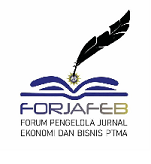KINERJA BANK UMUM SYARIAH BERDASARKAN MAQASHID SYARIAH INDEX
Abstract
This study aims to measure the performance of Sharia Commercial Banks (BUS) using the Maqashid Syariah Index (MSI), and compare the results using the capital structure of BUS. This study applies quantitative and comparative -descriptive methods based on data from the annual financial statements of 12 BUS Indonesia for the 2021-2022. Data analysis was conducted using three MSI indicators (ratios), namely educating individuals, upholding justice, and promoting prosperity, as the basis for evaluation. The results showed that in 2021, there were five BUS that obtained results above 0.1; in order, namely BTPNS, BAS, BMS, BSI, and BCAS. In 2022, there are BUS goals that obtain results above 0.1, respectively, namely BTPNS, BMS, BAS, BCAS, BSI, BNTB, BJBS. Measured by KBMI, BTPNS (KBMI 2) ranked 1st two years in a row; while BSI (KBMI 3) is only ranked 4th (2021), even in 2022 it fell to rank 5 (2022). This means that the capital structure (KBMI) is not positively correlated with MSI's performance.
Keywords
Full Text:
PDFReferences
Abu Zahrah, M. (1994). Ushul Fiqih (Terjemahan). Pustaka Firdaus.
Adzhani, R., & Rini, R. (2019). Komparasi Kinerja Perbankan Syariah Di ASIA Dengan Pendekatan Maqasid Syariah. Jurnal Akuntansi Dan Keuangan Islam, 5(1), 5–30. https://doi.org/10.35836/jakis.v5i1.11
Antonio, M. S., Laela, S. F., & Jazil, T. (2020). Abu Zahrah’S Maqasid Sharia Model As a Performance Measurement System. Jurnal Akuntansi Multiparadigma, 11(3), 519–541. https://doi.org/10.21776/ub.jamal.2020.11.3.30
Antonio, M. S., Sanrego, Y. D., & Taufiq, M. (2012). An Analysis of Islamic Banking Performance: Maqashid Index Implementation in Indonesia and Jordania. Journal of Islamic Finance, 1(1), 012–029.
Asutay, M., & Harningtyas, A. F. (2015). Developing Maqasid al-Shari’ah Index to Evaluate Social Performance of Islamic Banks: A Conceptual and Empirical Attempt. International Journal of Islamic Economics and Finance Studies, 1(1), 1–64. http://dx.doi.org/10.1037/xge0000076
Davi, A. O., & Indriawati, F. (2020). Risk, Governance, Earnings, Capital (Rgec) Method And Maqashid Sharia Index (Msi) : The Soundness Level Of Islamic Banks In Indonesia. February. https://doi.org/10.4108/eai.26-3-2019.2290770
Fathurrahman, A. (2014). Pendekatan Maqasid Syariah: Konstruksi terhadap Pengembangan Ilmu Ekonomi dan Keuangan Islam. Hunafa: Jurnal Studia Islamika, 11(2), 193–214. https://doi.org/https://doi.org/https://doi.org/10.24239/jsi.v11i2.354.193-214
Gozal, R. P. (2023). Kinerja BSI Semakin Solid. https://keuangan.kontan.co.id/news/kinerja-bsi-semakin-solid
Jazil, T., & Syahruddin. (2013). The Perfomance Measures Of Selected Malaysian And Indonesian Islamic Banks Based on The Maqasid Al-Shari’ah Approach. Ijtihad: Jurnal Hukum Dan Ekonomi Islam, 7(2), 279–301.
Kamali, M. H. (2011). Maqasid Al-Shari’ah and Ijtihad as Instrument s of Civilisational Renewal: A Methodological Perspective. ICR Journal, 2(2), 245–271. https://doi.org/10.52282/icr.v2i2.647
Koyyimah, A. K., Tanjung, H., & Ayuniyyah, Q. (2023). Pengaruh Likuiditas, Ukuran Perusahaan, Dan Risiko Pembiayaan Terhadap Kinerja Keuangan Bank Umum Syariah Tahun 2018-2022. Jurnal Syarikah : Jurnal Ekonomi Islam, 9(1), 47–60. https://doi.org/10.30997/jsei.v9i1.8742
Marimin, A., & Romdhoni, A. H. (2017). Perkembangan Bank Syariah di Indonesia. Jurnal Ilmiah Akuntansi Islam, 1(2). https://doi.org/10.29040/jiei.v1i02.30
Maulana, H., Lahuri, S. Bin, Ahmad, S., & Harahap, R. (2022). Pengembangan Kinerja Perbankan Syariah Berdasarkan Model Maqasid Al-Syari’ah. FINANSIA: Jurnal Akuntansi Dan Perbankan Syariah, 05(01), 71–84.
Mohammed, M. O., Razak, D. A., & Taib, F. M. (2008). The Performance Measurement of Islamic Banking Based on the Maqasid Framework. IIUM International Accounting Conference (INTAC IV), June, 1–17. https://doi.org/10.4324/9781315590011-6
Mukti, T. W., & Suprayogi, N. (2019). Apakah Bank Syariah Berbeda Dengan Bank Konvensional. Jurnal Ekonomi Syariah Teori Dan Terapan, 6(6), 1137–1152.
Nawawi, H. (2020). Konsistensi Penerapan Prinsip Syariah Dalam Penjelasan Pasal 2 Undang-Undang No 21 Tahun 2008 Pada Produk BNI Griya Ib Hasanah Di BNI Syariah Cabang Jember. Jurnal Qolamuna, 5(1), 303–324.
OJK. (2021). Peraturan Otoritas Jasa Keuangan (POJK) Nomor 12/POJK.03/2021 tentang Kelompok Bank Berdasarkan Modal Inti (KBMI).
OJK. (2022). Laporan Perkembangan Keuangan Syariah Indonesia 2021. https://ojk.go.id/id/kanal/syariah/data-dan-statistik/laporan-perkembangan-keuangan-syariah-indonesia/Pages/Laporan-Perkembangan-Keuangan-Syariah-Indonesia-2021.aspx
Pemerintah Indonesia. (1998). Undang Undang Nomor 10 Tahun 1998 tentang Perubahan atas UU Nomor 7 Tahun 1992. In Https://Peraturan.Bpk.Go.Id/.
Pemerintah Indonesia. (2008). Undang-Undang Perbankan Syariah Nomor 21 Tahun 2008 Tentang Perbankan Syariah.
Prasetyowati, L. A., & Handoko, L. H. (2019). Pengukuran Kinerja Bank Umum Syariah Dengan Maqasid Index Dan Sharia Conformity And Profitability (SCNP). Jurnal Akuntansi Dan Keuangan Islam, 4(2), 107–130. https://doi.org/10.35836/jakis.v4i2.22
Priyatno, P. D., Rohim, A. N., & Sari, L. P. (2022). Analisis Kinerja Bank Syariah di Indonesia Berbasis Maqashid Sharia Index. Jurnal Ilmiah Ekonomi Islam, 8(3), 2434. https://doi.org/10.29040/jiei.v8i3.6581
Putri, A. W., Mariana, & Jermias, J. (2023). The Effect of Bank Size, Good Corporate Governance And Islamic Corporate Social Responsibility (ICSR) on The Performance of Maqashid Sharia Islamic Commercial Bank In Indonesia. Proceeding International Economic Conference of Business and Accounting, 1.
Rahma, F. A., & Arifin, J. (2022). Faktor-faktor yang mempengaruhi kinerja maqashid syariah. NCAF: Proceeding of National Conference on Accounting & Finance, 4, 151–157. https://doi.org/10.20885/ncaf.vol4.art20
Ramadhani, R., & Mutia, E. (2016). Analisis Perbandingan Kinerja Perbankan Syariah Di Indonesia dan Malaysia Ditinjau Dari Maqashid Shariah Index. Simposium Nasional Akuntansi XIX Lampung, 1–24.
Sa’diyah, M., Gumilar, A. G., & Susilo, E. (2021). Uji Maqashid Syariah Perbankan Syariah Di Indonesia. Jurnal Ilmiah Ekonomi Islam, 7(1), 373. https://doi.org/10.29040/jiei.v7i1.1725
Setiyobono, R., Ahmar, N., & Darmansyah. (2019). Pengukuran Kinerja Perbankan Syariah Berbasis Maqashid Syariah Index Bank Syariah di Indonesia : Abdul Majid Najjar Versus Abu Zahrah. Jurnal Riset Akuntansi & Perpajakan (JRAP), 6(02), 111–126. https://doi.org/10.35838/jrap.v6i02.1249
Solihin, K., Ami’in, S. N., & Lestari, P. (2019). Maqashid Shariah Sebagai Alat Ukur Kinerja Bank Syariah Telaah Konsep Maqashid Sharia Index (MSI) Asy-Syatibi. Laa Maisyir: Jurnal Ekonomi Islam, 6(3), 148–170. https://doi.org/https://doi.org/10.24252/lamaisyir.v6i2.11790
Wahid, N. N., Firmansyah, I., & Fadillah, A. R. (2019). Analisis Kinerja Bank Syariah Dengan Maqashid Syariah Index (Msi) Dan Profitabilitas. Jurnal Akuntansi, 13(1), 1–9. https://doi.org/10.37058/jak.v13i1.710
Wahyulaili, K., Puspitasari, N., & Singgih, M. (2018). Analisis Pengaruh Good Governance Bisnis Syariah, Ukuran Perusahaan, dan Struktur Modal terhadap Kinerja Perbankan Syariah. Indonesian Journal of Islamic Economics & Finance, 10(3), 27–47.
Wiranata, Y. A., & Nugrahanti, Y. W. (2013). Pengaruh Struktur Kepemilikan Terhadap Profitabilitas Perusahaan Manufaktur di Indonesia. Jurnal Akuntansi Dan Keuangan, 15(1), 15–26. https://doi.org/10.9744/jak.15.1.15-26
Yusnita, R. R. (2019). Analisis Kinerja Bank Umum Syariah Dengan Menggunakan Pendekatan Islamicity Performance Index Periode Tahun 2012-2016. Jurnal Tabarru’: Islamic Banking and Finance, 2(1), 12–25. https://doi.org/10.25299/jtb.2019.vol2(1).3443
Yusro, R., & Atiqah, A. (2021). Modal Intelektual Islam dan Ukuran Perbankan terhadap Kinerja Maqashid Syariah. Akuntabilitas, 14(2), 201–214. https://doi.org/10.15408/akt.v14i2.22507
DOI: https://doi.org/10.32502/jab.v9i1.8249
Refbacks
- There are currently no refbacks.
Program Studi Akuntansi Fakultas Ekonomi dan Bisnis, Universitas Muhammadiyah Palembang
Jl. Jenderal A. Yani 13 Ulu, Seberang Ulu II, Palembang (30263), Indonesia.
Indexed by :














.jpg)


